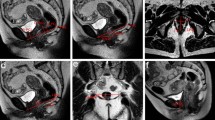Abstract
Background
Pelvic floor dysfunction and prolapse affect 50 % of women past middle age. Failure to recognize the complex set of pelvic floor defects in individuals leads to most post-surgical failures. Imaging has so far not had an established role in the investigation of prolapse. The present study is an attempt to define the role of magnetic resonance imaging in POP.
Materials and methods
Thirty patients with clinically graded stage III/IV prolapse underwent routine physical examination and grading of POP in the Department of Obstetrics and Gynaecology, AIIMS. Dynamic MR evaluation with TRUFISP configuration was done and organ prolapse was measured through the hiatal line (HMO classification). The agreement of MRI, physical examination and intra-operative examination was analyzed using kappa as the test of agreement.
Observations and results
Twenty-eight subjects with grade III and 2 subjects with grade IV prolapse were enrolled. The mean age was 52.8 and the mean parity was 3.63. On MRI, 19 patients were found to have grade III prolapse, 4 had grade IV prolapse and the rest had grade I and II prolapse. There was poor agreement of MRI with clinical examination in anterior and middle compartments (k 0.161, k 0.144). The agreement between MRI and Intra-operative findings was 0.369, 0.422 for anterior and posterior compartments. Kappa was 0.085 for rectocele and 0.710 for enteroceles. The agreement was better for posterior compartment and enterocele. MRI detected 5 out of 8 enteroceles intra-operatively.
Conclusion
The study demonstrates that while dynamic MRI does not confer any additional advantage in the diagnosis of anterior and middle compartment defects, the diagnosis of enteroceles, which may be missed clinically, is efficiently made on dynamic MRI imaging. Additionally, MRI can differentiate enterocele from a high rectocele which can further classify the surgery needed. There is also a need to standardize the protocol and the role of MR imaging in POP.




Similar content being viewed by others
References
Maglinte DD, Kelvin FM, Hale DS, Benson JT (1997) Dynamic cystoproctography: a unifying diagnostic approach to pelvic floor and anorectal dysfunction. AJR Am J Roentgenol 169(3):759–767
Yang A, Mostwin JL, Rosenshein NB, Zerhouni EA (1991) Pelvic floor descent in women: dynamic evaluation with fast MR imaging and cinematic display. Radiology 179(1):25–33
Olsen AL, Smith VJ, Bergstrom JO, Colling JC, Clark AL (1997) Epidemiology of surgically managed pelvic organ prolapse and urinary incontinence. Obstet Gynecol 89(4):501–506
Kelvin FM, Maglinte DD, Hale DS, Benson JT (2000) Female pelvic organ prolapse: a comparison of triphasic dynamic MR imaging and triphasic fluoroscopic cystocolpoproctography. AJR Am J Roentgenol 174(1):81–88
Boyadzhyan L, Raman SS, Raz S (2008) Role of static and dynamic MR imaging in surgical pelvic floor dysfunction. Radiographics 28(4):949–967
Bump RC, Mattiasson A, Bø K, Brubaker LP, DeLancey JO, Klarskov P et al (1996) The standardization of terminology of female pelvic organ prolapse and pelvic floor dysfunction. Am J Obstet Gynecol 175(1):10–17
Kelvin FM, Hale DS, Maglinte DD, Patten BJ, Benson JT (1999) Female pelvic organ prolapse: diagnostic contribution of dynamic cystoproctography and comparison with physical examination. AJR Am J Roentgenol 173(1):31–37
Bertschinger KM, Hetzer FH, Roos JE, Treiber K, Marincek B, Hilfiker PR (2002) Dynamic MR imaging of the pelvic floor performed with patient sitting in an open-magnet unit versus with patient supine in a closed-magnet unit. Radiology 223(2):501–508
Fielding JR (2003) MR imaging of pelvic floor relaxation. Radiol Clin North Am 41(4):747–756
Agildere AM, Tarhan NC, Ergeneli MH, Yologlu Z, Kurt A, Akgun S et al (2003) MR rectography evaluation of rectoceles with oral gadopentetate dimeglumine and polyethylene glycol solution. Abdom Imaging 28(1):28–35
Lienemann A, Sprenger D, Janssen U, Grosch E, Pellengahr C, Anthuber C (2004) Assessment of pelvic organ descent by use of functional cine-MRI: which reference line should be used? Neurourol Urodyn 23(1):33–37
Cortes E, Reid WMN, Singh K, Berger L (2004) Clinical examination and dynamic magnetic resonance imaging in vaginal vault prolapse. Obstet Gynecol 103(1):41–46
Fauconnier A, Zareski E, Abichedid J, Bader G, Falissard B, Fritel X (2008) Dynamic magnetic resonance imaging for grading pelvic organ prolapse according to the International Continence Society classification: which line should be used? Neurourol Urodyn 27(3):191–197
Lienemann A, Anthuber C, Baron A, Kohz P, Reiser M (1997) Dynamic MR colpocystorectography assessing pelvic-floor descent. Eur Radiol 7(8):1309–1317
Goodrich MA, Webb MJ, King BF, Bampton AE, Campeau NG, Riederer SJ (1993) Magnetic resonance imaging of pelvic floor relaxation: dynamic analysis and evaluation of patients before and after surgical repair. Obstet Gynecol 82(6):883–891
Pannu HK, Kaufman HS, Cundiff GW, Genadry R, Bluemke DA, Fishman EK (2000) Dynamic MR imaging of pelvic organ prolapse: spectrum of abnormalities. Radiographics 20(6):1567–1582
Gousse AE, Barbaric ZL, Safir MH, Madjar S, Marumoto AK, Raz S (2000) Dynamic half Fourier acquisition, single shot turbo spin-echo magnetic resonance imaging for evaluating the female pelvis. J Urol 164(5):1606–1613
Tunn R, Paris S, Taupitz M, Hamm B, Fischer W (2000) MR imaging in posthysterectomy vaginal prolapse. Int Urogynecol J Pelvic Floor Dysfunct 11(2):87–92
Maglinte DD, Kelvin FM, Fitzgerald K, Hale DS, Benson JT (1999) Association of compartment defects in pelvic floor dysfunction. AJR Am J Roentgenol 172(2):439–444
Hodroff MA, Stolpen AH, Denson MA, Bolinger L, Kreder KJ (2002) Dynamic magnetic resonance imaging of the female pelvis: the relationship with the pelvic organ prolapse quantification staging system. J Urol 167(3):1353–1355
Broekhuis SR, Fütterer JJ, Hendriks JCM, Barentsz JO, Vierhout ME, Kluivers KB (2009) Symptoms of pelvic floor dysfunction are poorly correlated with findings on clinical examination and dynamic MR imaging of the pelvic floor. Int Urogynecol J Pelvic Floor Dysfunct 20(10):1169–1174
Conflict of interest
None.
Author information
Authors and Affiliations
Corresponding author
Rights and permissions
About this article
Cite this article
Gupta, S., Sharma, J.B., Hari, S. et al. Study of dynamic magnetic resonance imaging in diagnosis of pelvic organ prolapse. Arch Gynecol Obstet 286, 953–958 (2012). https://doi.org/10.1007/s00404-012-2381-8
Received:
Accepted:
Published:
Issue Date:
DOI: https://doi.org/10.1007/s00404-012-2381-8




